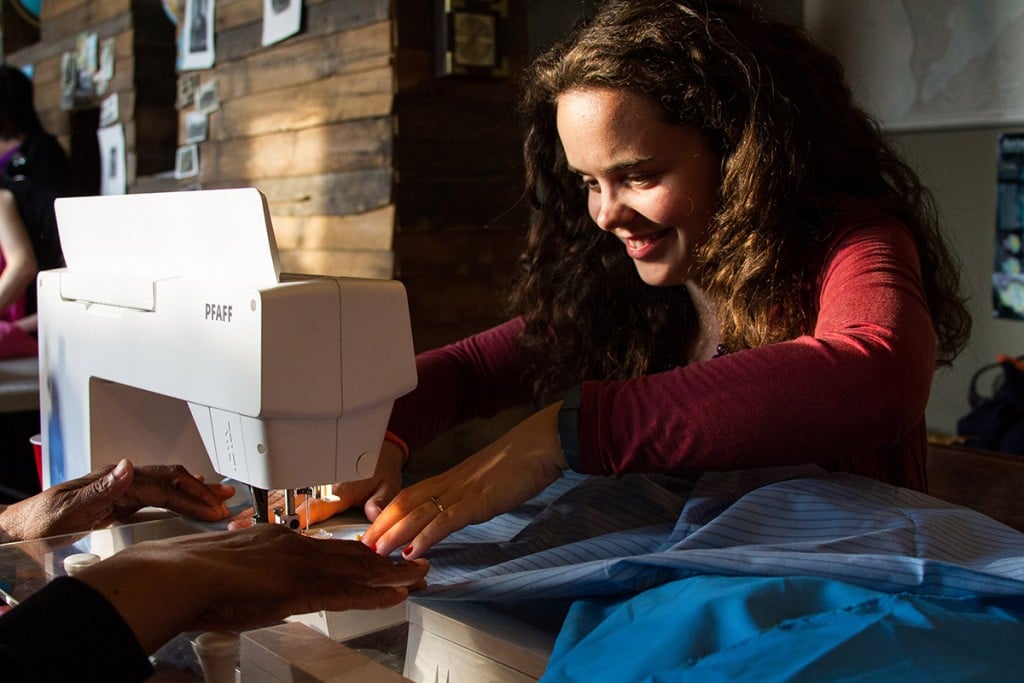Updated March 15, 2022 for Equal Pay Day. Originally published in 2016.
Shero: Lillis Taylor, Founder of The March Quilts and Executive Director of Bib and Tucker Sew-Op. Lillis’s work as Director of Bib and Tucker has brought women together in a creative and empowering environment. As founder of The March Quilts, she has carried that message of empowerment to the larger community and is addressing issues that impact everyone.
The March Quilts is a project that began in 2015 when Bib & Tucker Sew-Op partnered with community organizations to commemorate the 50th anniversary of the Selma to Montgomery marches through open sewing sessions that yielded 461 quilt blocks. The end product was three quilts which hung at the Selma Public Library and the Alabama Department of Archives in Montgomery during the anniversary.
Year 2 (2016) focused on pay equity. Simply put, women today are paid less than men. On average, a Caucasian woman makes approximately 79 cents for every dollar paid to her male counterpart. The gap is even worse for women of color – African American women earn approximately 64 cents and Latina women earn only 55 cents for each dollar earned by Caucasian males. Despite President Kennedy’s Equal Pay Act of 1963 and President Obama’s Lilly Ledbetter Fair Pay Act of 2009, equality in the US workforce continues to be unattainable.
GirlSpring (GS): How did you come up with the topic for Year 2?
Lillis Taylor (LT): We decided that because of the popularity of Year 1, that we would continue the project and focus on a civil or human rights issue each year. Specifically I read the book Grace and Grit, by Lanier Scott Isom, which is about Lily Ledbetter, a woman who worked for Goodyear in Gadsden and brought pay equity for women into the spotlight. I learned a lot from the book that I
didn’t know about the huge inequalities in pay for women, and I wanted to focus on this for Year 2.
We enlisted a UAB student, Lisa Nguyen, to design the logo for this year’s March Quilts, which features a pie chart representing the gender gap in wages, and she chose the color purple which is the color of the Suffragette movement. We also chose purple as the background color for the quilt
squares this year.
GS: Have the Year 2 quilts (pay equity) been completed?
LT: We had community open sewing sessions in January and February and we collected quilt squares, but not as many as last year. We are going to make one quilt, and because we have less squares, this gives us the opportunity to do some design work. We plan to incorporate the numbers of three different pay wages of women into the quilt design (Caucasian women get 79 cents per dollar compared to men, African-American women get 64 cents, and Latina women get only 55 cents). Ultimately, the quilt will hang at the Birmingham Museum of Art later in 2016.
GS: Why do you think there were less squares?
LT: I think with last year’s focus on civil rights, people were very familiar with the issue and knew exactly what they wanted to do, but this issue is different. People don’t talk about it as much, and so people don’t really know what to think about it, and that makes it harder for people to wrap their heads around it.
GS: Once people started working on the squares, do you think that they then became more interested in the topic of equal pay?
LT: I think we were coming at it as a way to educate people about the topic, the belief being that people should get equal pay for equal work, but what we learned was that not everyone agrees with that. So, what we ended up doing, was even taking a step further back to really get that conversation started. It’s a sensitive issue because you are talking not only about equality, but also about money,
and that is always a touchy subject. We hope that we will have the chance to showcase the quilt a few times over the next few months so that we can use it as a starting point for more open forum discussions.
GS: Is there anything that really stands out to you about this project?
LT. Yes. One really beautiful thing that happened as a result of the project, was that the Bib and Tucker women, especially some of the older women really opened up and shared their stories about pay inequality that they had experienced.
GS: Were you always interested in quilting?
LT: No, so my maternal grandmother, who died when I was 2 was an excellent seamstress, but I was not. I have pictures of my mom trying to teach me to sew and I just wasn’t interested at all. Then, in 2007, I went to Gees Bend and met the quilters there, and was just really moved by what they were doing. I have a background in industrial design, so anything that involves beauty and utilitarian function inspires me. When I turned 30, it seems that the stars aligned and I found my groove and had patience enough to commit to this slow art form. So, although I haven’t always sewn, I feel like now I’m communing with my grandmother.
GS: What advice would you give to teen girls who are interested in sewing, or fashion, or quilting?
LT: Birmingham is a different place than it was when I grew up. There are so many young people, right out of college that have great ideas and are doing great things. Meeting one person can be a catalyst these days because the community is linked up through social media and organizations like GirlSpring. If you find one person, chances are, that will lead you to a whole group of like-minded people.

